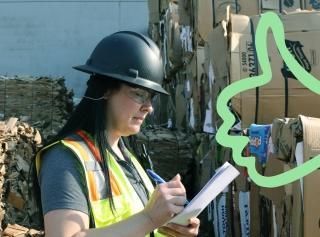Millennial and Gen Z consumers, collectively, those born between 1981 and 2012, are by far the most vocal when it comes to demanding environmental impact reduction. For example, 47 percent of Gen Z consumers want the brands they shop to support the environment, climate change, and sustainability, according to a 2023 ICSC survey. They are also the fastest growing groups of retail shoppers, and will surpass the purchasing power of Baby Boomers by 2030, according to research published in Harvard Business Review.
In response, large retailers have an edge when it comes to recycling potential. They have more space, resources, and recyclable packaging material to implement circular solutions, as we noted previously. Smaller retailers are less fortunate.
Small to medium-sized retailers make up the majority of stores in commercial shopping centers. They face the same pressure from consumers as the big anchor stores—perhaps more intensely, given the more intimate shopping experience and specialized clientele. But it is far more difficult for them to act on their own, even when they feel as strongly as their customers do about sustainability and climate change. Their space is limited, and they often lack efficient waste management options. Their store’s typical volume of recyclable packaging waste is too small—or so they believe.
But the potential for low-cost environmental impact reduction is surprisingly good for these smaller retailers and their commercial property owners. With an equitable green lease framework, and with the right provider of recycling, their combined effort can reduce greenhouse gas emissions, divert waste from landfills, and create a net positive economic value.
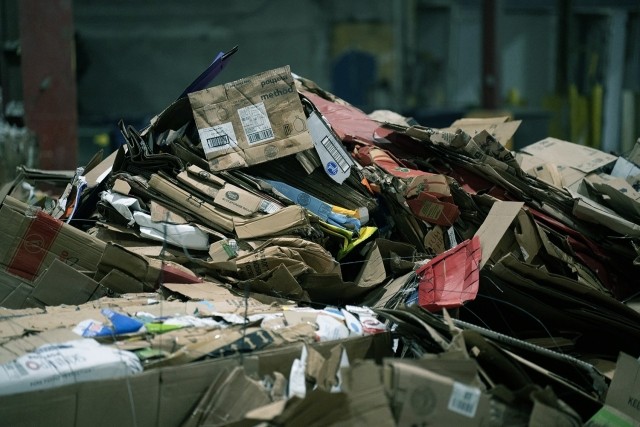
The Retail Landscape
It is fashionable to declare that shopping malls are dead or dying in North America. But these doom-and-gloom forecasts are overstated, to say the least. Large chain department stores are indeed undergoing economic stress, compounded by the impact of e-commerce and of course the lingering effects of COVID restrictions. But that’s not the whole story. Revenue growth, occupancy rates and foot traffic have bounced back since the pandemic, especially at top-tier malls. In early 2023, according to Coresight Research, 12.9 percent of U.S. consumer spending on retail goods and retail-adjacent services went through malls, outperforming all other retail formats per square foot.
Malls and their stores are also adjusting to the realities of e-commerce. Many have added new services to their business model, according to Scot Case, Sustainability VP for the National Retail Federation (NRF).
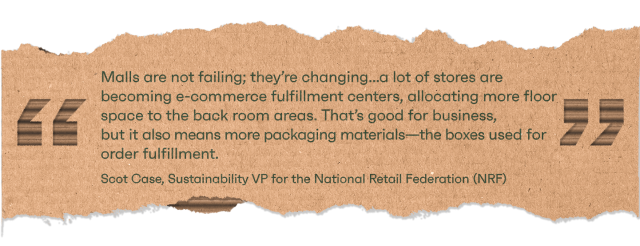
All this adds up to an opportunity—and a challenge—for retailers. With ever-increasing pressure from Millennial and Gen Z shoppers to be more sustainable, retailers must find genuine solutions, offering more sustainable products and packaging. Increasingly, this means shifting towards fiber-based packaging, such as corrugate and paperboard that can be more easily converted into new packaging in a circular, closed-loop recycling process. As Case noted, the emerging circular economy is integral to the NRF’s overall approach to retail sustainability.
The problem, however, is that smaller retailers have less space and comparatively smaller volumes of recyclable packaging material than their larger, anchor store neighbors. Fortunately, there is a solution. Mall property owners are under pressure from investors and regulators to reduce their buildings’ environmental impact. Their facilities also have common waste collection areas for their tenants, who are contractually obligated to use them. By adding low- or no-cost recycling provisions to their leases, both owners and their tenants would benefit, satisfying demands for greater sustainability and reduced emissions, while also freeing up more space for retail operations. “In the world of retail, Case added, “if there are ways to increase recycling, it benefits everybody equally.”
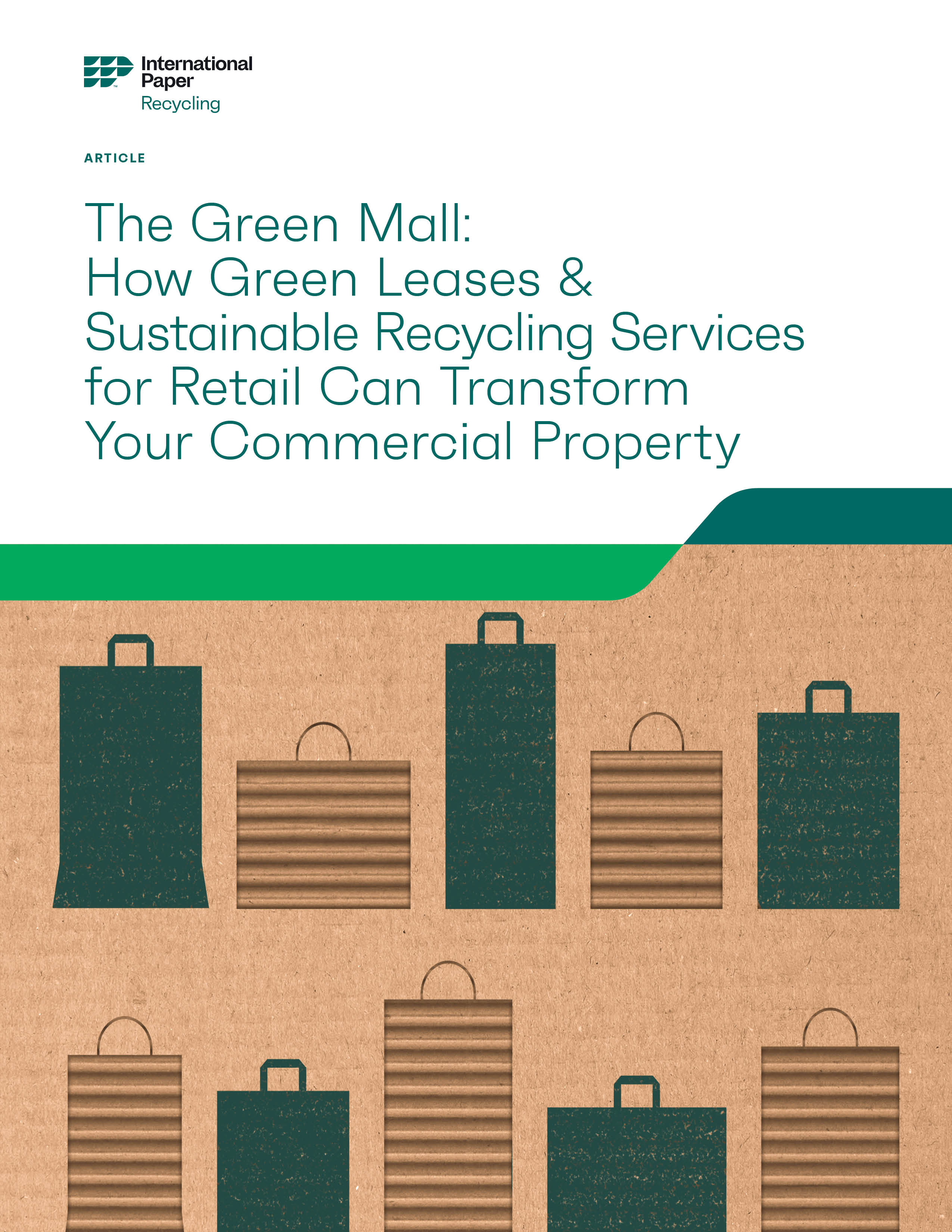
The Green Lease Equation
The Institute for Market Transformation (IMT) bridges the intersection of business, government, and community priorities to spotlight business practices and advance public policy to improve U.S. buildings.
One of the means IMT employs to achieve these goals is their advocacy of green leases, also known as high-performance leases, between building owners and their tenants. Reflecting a collaboration between landlords and tenants, these leases are designed to align sustainability and financial incentives between both parties, leading to lowered carbon emissions through efficiencies in energy and water use, as well as more effective recycling of waste materials.
IMT’s Diana Lee leads the group’s Green Lease Leaders program, setting national standards for the practice. She noted that the practice has evolved significantly, from just a “check-the-box” compliance requirement to a more performance-based approach. “Green leases are becoming more sophisticated, incorporating more clauses about accountability between landlord and tenant,” Lee said. Participants in its Green Lease Leaders program, established in partnership with the U.S. Department of Energy, now own or operate over 8.1 billion square feet of commercial and governmental building space.
One provision of modern green leases addresses what Lee referred to as a “split incentive.” In the past, tenants might receive the financial benefits of energy- or water-saving capital improvements paid for by the landlord, reducing the latter’s incentive to act. But under the terms of a green lease’s cost recovery clause, the savings would be shared.
Lee acknowledged that waste recycling is currently the less common of the three elements of green lease provisions, in part because the other two—energy and water use—are easily measured. However, if the recycling service provider had sufficient means to separate and measure the types of waste materials (fiber, wood, glass, etc.) and manage the recovery process accordingly, she acknowledged that the green lease can play a strong role in supporting recycling and its emissions reduction.
For retailers, there are multiple incentives for landlords and tenants to pursue this approach. One is the enactment of building performance standard policies in major cities, as well as the requirements of numerous state and federal laws. But there are positive aspects as well as compliance-based ones. These include substantial economic savings, more equitable cost sharing, and of course the reality-based enhancement of the retailers’ (and the retail malls’) public-facing brand reputation.
Another incentive for building owners is simply the law of supply and demand. Lee noted that by 2030, demand in the U.S. for low-carbon office buildings will outstrip supply by 75 percent! Making your retail buildings more energy-, water-, and waste-efficient—and using green leases to get there—simply makes business sense.
The Circular Route
According to the EPA, “old corrugated containers,” or OCC, typically contributes 30-40 percent of a shopping center’s waste stream. As we noted in a previous article, this represents an enormous potential value stream as a source of fiber for new packaging. Sources of OCC are numerous, including shipping boxes and retail-ready displays. Other fiber sources include folding cartons and office paper, all of which can be reclaimed with the addition of new fiber from sustainably managed forests, to produce new products.
Non-fiber components of a shopping center’s waste stream, such as wooden pallets, metals, and plastics, must be separated and handled differently—preferably through reputable partners. The remaining fiber-based materials are then compacted and shipped, preferably to a nearby facility for processing fiber-based products.
The benefits to the shopping center and its tenants are undeniable. If the recycling process is handled efficiently, the aggregate reduction of waste to landfill is substantial, as is the corresponding reduction in greenhouse gas emissions. There are also incremental savings in waste management and of course an increase in space available for other purposes.
What About Industrial Parks?
For owners of industrial use properties, the environmental and building performance requirements are the same as they are for shopping malls and office buildings, but the dynamics are very different, according to commercial leasing attorney, Ellen Sinreich. “The owners of industrial parks and the owners of shopping centers—and the ways those two kinds of properties work—are different,” she said. “Shopping centers often have shared waste disposal areas, managed by the landlord. With industrial properties, it’s each man for himself. The landlord often isn’t involved.”
In general, industrial parks and their tenants are more removed from public scrutiny, Sinreich noted, so there is less motivation to invest in recycling and greenhouse gas reduction. However, pressure from regulatory bodies, particularly in major metropolitan areas, will likely push some industrial park owners in that direction.
The ultimate incentive for this group is likely to be a purely economic one. If a landlord, under pressure to change their Environmental, Social, and Governance (ESG) rating, approaches their industrial tenants with a low-cost (or no-cost) recycling solution, the tenant is more likely to go along, especially if it results in more operational space.
There are already some great examples of retailers and shopping centers taking a proactive stance when it comes to recycling. The Mall of America in Bloomington, Minnesota, Westfield Shoppingtown Mission Valley in San Diego and VF Outlet Shopping Village in Reading, Pennsylvania have each diverted a large majority of overall waste, including a high percentage of OCC. In each case, substantial cost savings and income generation were achieved, along with corresponding reductions in waste to landfill. These examples serve as proof of concept for mall property owners as a whole.
The catch for commercial retail properties is that this requires participation by all tenants, not just the big box or anchor stores. Separately, the smaller stores do not have the means to accomplish this, but as a group they can. Through the use of equitable green leases, voluntary collaboration, or a combination of the two, even small retailers can help accomplish these goals. All they need is a partner capable of performing all the steps in the circular recycling process—at scale.
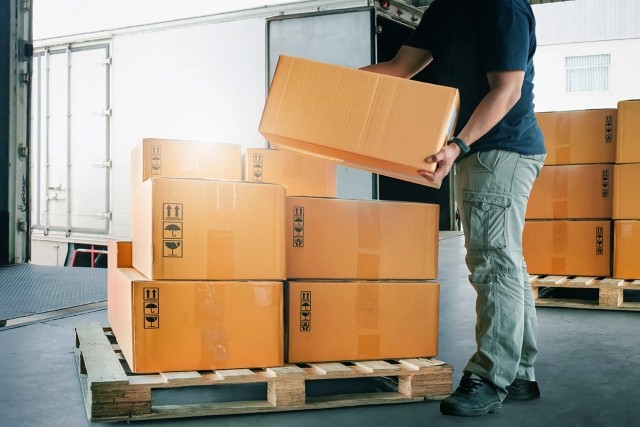
How It's Done
For smaller retailers in a mall or shopping center (or for any commercial tenant, for that matter) the problem of closed-loop recycling can only be solved through a joint effort involving the landlord. (This can be reinforced through green lease provisions, but it can also be done informally.)
When it comes to OCC, one of the most recyclable materials used by retailers, here are the basic steps:
1. The retailer collects all fiber-based waste, including OCC, folding cartons, and other materials, and takes it to a central location at the mall or shopping center. That location, owned by the landlord, frees up space for the retailer for displays and other purposes.
2. The recycling provider collects the waste and transports it to a nearby regional recycling plant.
3. The recycled fiber is put back into the manufacturing process at the paper mill, where it is pulped and mixed with a measured amount of fresh pulp from sustainably managed forests. From the mill, the resulting paper is sent to a regional converting facility—creating new boxes, bags, retail displays, etc. from old ones.
4. The new boxes are used in several different ways. Manufacturers, for instance, use the boxes to ship products to retailers. This circular recycling process includes a growing number of manufacturers and retailers. Under the auspices of the mall or shopping center, they collectively use and re-use the same renewable material—fiber—many times. This achieves the goal of lowering total organic waste to landfills, which have been identified as the third largest source of methane emissions in the U.S., according to a Rocky Mountain Institute study.
International Paper’s recycling services encompass all the steps necessary to make this happen, whether it be for manufacturers, offices, grocery outlets, or general retailers. Its network of regional collection and processing facilities allow for the safe and efficient removal—and measurement—of the retail waste stream, allowing retail property owners and their tenants to document their ESG profiles, optimize space usage, and truthfully represent their sustainability credentials to the general public.
At International Paper, the leading experts in renewable, fiber-based products are creating the future’s fiber-based packaging solutions. Every day the world moves forward with new ideas, new technologies and new priorities. And every day, we work to make the world better, safer and more sustainable so our customers can thrive. Please feel free to share this article and contact us today to request a free recycling audit and a free, customized recycling plan.



